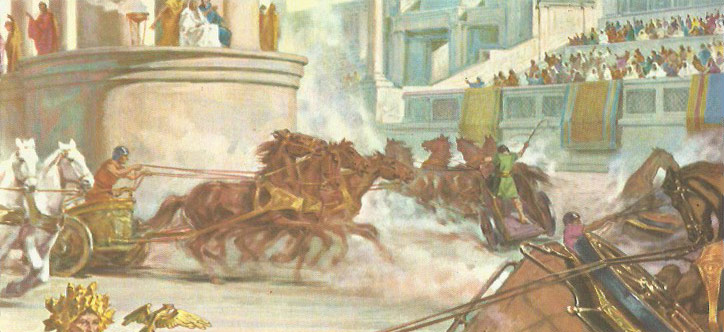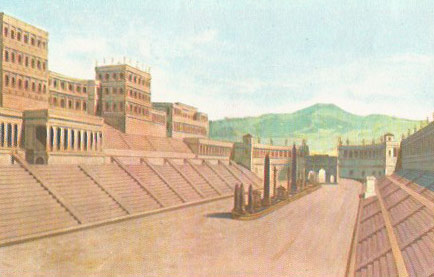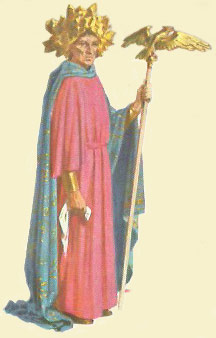chariot racing in ancient Rome

Rounding the meta at a chariot race in Rome.

A reconstruction of the Circus Maximus at Rome, which stood between the Palatine and the Aventine hills.
"I am no better known than the race-horse Andraemon," complained the Roman poet Martial at the height of his fame. He was not exaggerating, for the Roman people were fanatics of horse racing, and both successful riders and their horses enjoyed fame and fortune.
Let us imagine ourselves in Rome on one of the numerous holidays during the Imperial Age. We can be sure that the Emperor, or some wealthy citizen, has arranged for a show of some sort to be put on for our entertainment on one of the many amphitheaters, circuses, or theaters with Rome is packed. Although the bloodthirsty gladiatorial fights in the amphitheaters are extremely popular, today's entertainment promises to be just as exciting. For the Emperor himself is to preside over the races he is holding in the Circus Maximus, and we must be there very early if we are to get good seats. Some enthusiasts, in fact, have been in the Circus all night, and the Emperor has sent his guards to keep them quiet.
In the Circus the crowd grows steadily, and the uproar increases, as sellers of drinks and sweets peddle their wares. The top tier of wooden seats is reserved for the common people; in front of them are the stone seats kept for members of the Senate, knights, priests, including the Vestal Virgins and other important officials. A special box is reserved for the Emperor and is court.
The Circus
The Circus Maximus, in which these races took place, was not round, as the name might suggest, but oblong, and it lay in a valley between the Palatine and the Aventine hills, in a spot suitable for such a sport. It had been used for meetings from the earliest days, but at first the Romans had to be content with sitting on the bare earth. But the early emperors, especially Augustus, Nero (whose enthusiasm for chariot racing was so great that he himself took part in races), Domitian, and Trajan, all helped to enlarge and beautify it. Eventually it could seat 255,000 people, many more than any modern stadium; Wembley for instance, the largest in England, seats only 55,000.
The races were run round the spina, originally a mound of earth in the center of the course which was later decorated with statues and shrines. The normal length of a race was seven laps, and as each lap was completed a golden dolphin was lowered. The critical moments in the race came during the rounding of the matae, the turning posts at each end of the spina. It was there that the driver's skill was most tested; and he had to go as close as possible to the meta without actually touching it and so overturning his chariot. As the driver always had the meta to his left, the best horse in the team was placed on the left, and success largely depended upon the co-operation between the driver and the two outside horses, the funales (from the Latin funis, rope); these were only attached to the chariot by rope, while the rest of the team were in harness.
Champions of 2,000 years ago
The chariots were normally drawn by teams of two or four horses, but on some occasions six, eight, or even ten were used. In addition to displaying his skill at driving, te charioteer, or aurgae agitator, might perform more purely acrobatic tricks, such as guiding two horses at once, leaping from one to the other, snatching a piece of cloth from the ground, or kneeling on his galloping horse. The names of the champion jockeys have been preserved for us; Scorpus won 2,048 times. Pontius Epaphroditus 1,467 times, and Diocles, after winning 1,462 times, retired from racing with a fortune of 35 million sesterces, worth several million dollars in modern currency. The names of many horses, too, have been preserved for us, either from inscriptions made by their proud owners or from the sheets of bronze on which disappointed 'punters' had condemned them to destruction by the gods of the underworld. We hear of Tuscus who won 386 times, and Victor who lived up to his name with 429 victories. Their names have also been found on clay pots and in mosaics on the floors of houses.
Chariots racing in Rome aroused the same spirit and excitement, enthusiasm, and rivalry that football does today. Each of the four chariots was supported by one of four 'factions'. These were known as the Greens, the Reds, the Whites, and the Blues. The supporters of the different factions spent immense sums to obtain the services of the best drivers and horses, and paid large bands of supporters to applaud their chariot. Politics entered into the rivalry between the factions, and sometimes feelings in the Circus ran so high that fights broke out with which had to be quelled by force. Even the emperors entered into this rivalry between the factions, and sometimes used their authority to ensure the victory of the faction they supported. On one occasion the Emperor Caracalla had the charioteers of the factions opposing his arrested and put to death.
 |
| The official presiding at the races in his traditional dress
|
The starting signal was given by the emperor or consul who was presiding. He threw a white napkin into the ring as the heralds blew a trumpet blast. Over a scarlet tunic he wore a richly embroidered toga; in his hand he held an ivory staff surmounted by a flying eagle, while on his head he wore a wreath of golden leaves, so heavy that a slave stood by him to help him bear the weight.
